

6 April - 24 May 1453
The siege of Constantinople represent another example of the ancient confrontation between East and West, which in this case marks the moment of maximum splendour of the Turkish power.
CONSTANTINOPLE
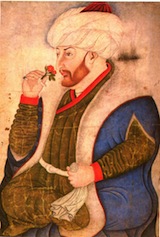
Mehmed II El Fatih (the Conqueror), also called Humkar ("bloodthirsty"), properly speaking five languages, and was interested in poetry and philosophy. Wanted to visit the ruins of Troy and love to read the exploits of Alexander the great. Maybe it was from those readings that got the inspiration for his hatred against the West.
In 1451, just 21-year-old, Muhammad II had already ascended the throne succeeding his father Murad II, who, despite the long periods spent in war, had managed to reorganize the Administration and to encourage the development of Sciences and arts, pressing with his "influence" to "sponsor" the nomination of the future King of the Eastern Roman Empire Constantine XI Palaiologos.
After getting rid of his only brother, Ahmed, built the fortress of Rumeli Hisar on the European shore of the Bosphorus to block supplies from the Black Sea to the city of Constantinople. After the fall of the city, he moved the turkish capital and renamed it Istanbul, Turkish deformation of the Greek "stin bolin" (in town), and rededicated as a mosque Hagia Sophia's Cathedral.
Afterwards, the Turkish invasion arrived in Croatia, Bosnia and the entire Peloponnese except Rhodes. Muhammad, aware of internal divisions in the Western States, was able to take advantage of this situation by granting privileges to merchants Venetians and Greeks, besides reconfirming those already previously held by the Genoese, getting, thanks to duties and taxes, a fortune, large enough to build a huge fleet.
With Mehmed II the Turkish Empire would reach boundaries that were previously held by Byzantium itself at the time of its greatest glory. He died suddenly in 1481 when was preparing an invasion of Italy.
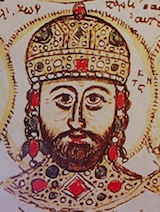
Son of Emanuel II Palaiologos at twenty-six years old defeated the Franks in Morea, and managed to keep almost always the Turks out of Boeotia and Thessaly. After the contention for the throne with his brother Demetrius, in 1449 he became the last Roman Emperor of the East.
Despite completely disinteress of the West about the fate of Constantinople, Constantine sought to mend relations between the the Eastern Orthodox Church and the Roman Catholic one, as to create a front of solidarity and save at least the city, the only thing that remained of the old Empire. His people and the clergy, however, were still mindful of the Crusaders sacking of the city itself in 1204, then not supported this initiative. Even Venice and the Church of Rome limited their support to the Byzantines.
The Constantine resistance on the city walls was so tough that the Turks were tempted more than once to abandon the siege of the city. The last of the basileus died on a gap at the head of a handful of nobles while the janissaries had already broke inside the city.
Belonging to one of the most powerful clans in Genoa, formed from the merger of several very comercially active families, renounced his original surname for that of the building where resided his Agency (Palazzo Giustiniani, in fact). The Commander of the defence of Constantinople, Giovanni Giustiniani-Longo, was podestà of Kaffa at the time of the Turkish offensive.
On its own initiative had reached the city with two galleys and 700 men, escaping the massive naval blockade action of the Turks. Tursunzoda Beg, the historian of Mehmed II, said that "the leader of the demons" would have been pierced by a ghazi (soldier without pay, who lived only of the spoils of war) on the outer wall of the city while was unleashing the last assault. For Venetians and Greeks historians, would have been him instead to spread panic among the besieged, spreading false news that the Turks were already in the city; barely saved by his companions while Constantinople fallen he had been conducted on the island of Chios where he later died.
CONSTANTINOPLE
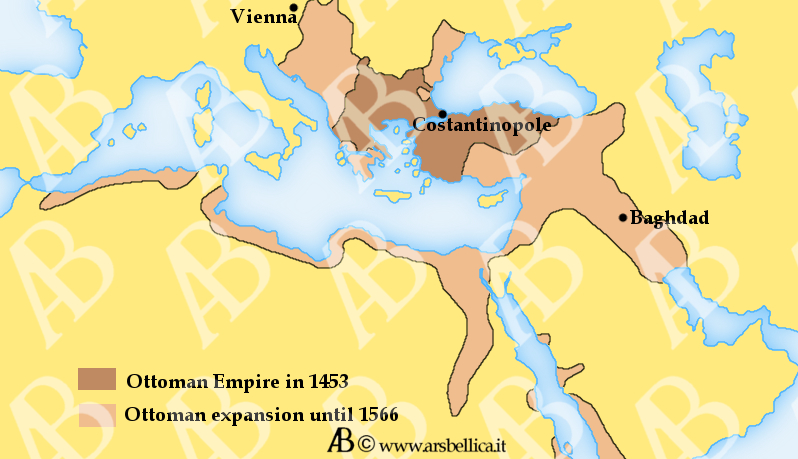
The fall of the city of Constantinople is an example of the ancient clash between two civilizations: the West and the East, which, as in the Greek myths, would cause a series of bereavements and of infinite woes for Christianity. The "second Rome" had fallen, and a thousand-year Empire with it, while the "great fear of the world ", i.e. the Turks, overlooked dangerously on the continent after destroying the last Christian stronghold that had been placed between Europe and Asia. In other words, both Rome and Venice as the Holy Roman Empire saw at their horizons no longer the cross of Christ but the green flags of the Prophet.
The term "Turkish" indicates generally a collection of nomadic peoples and farmers who lived in the north-eastern steppes of Asia. The word Turk ("strength") is found for the first time in the 5th century AD, when those Nations allied with the Wei of northern China against Juan-Juan that probably kept them in slavery.
Once defeated the latter, the Turks seized their territories and their leaders took the title of Khagan or Khan who later created a vast Kingdom in Central Asia, but considering the internal discords (typical of nomadic tribes) was dissolved soon. The Turks were defeated first by the T'ang dynasty in the 8th century, and later by the Arabs at the battle of Talas River (751).
Their military value remained unchanged, however, the Caliph al-Mu'tasim began to recruit troops from the Buyidi tribe, who eventually inherited the Arab military power management although formally remaining mercenaries. In 1055 another Turkish tribe the Selgiukids overthrew the power of the Buyidi to seize power once and for all, by setteling in Baghdad. The Caliph (to whom remained the religious and moral power) was replaced by the "Sultan", the "holder of absolute power": it was one of the first sultans to defeat at Manzikert the Byzantine army of Emperor Romanus I.
From there onwards the destinies of the Turks and the Byzantines were always connected in one way or another, even if the Selgiukids were overthrown by the Mongol invasion of Hugalu, and replaced by another Turkish tribe, if possible even more fierce, the Ottomans one, from the name of their first Lord Osman, Othman.
The war between the Eastern Roman Empire and the Ottoman Empire, with the exception of short periods of non-belligerency, did not have many stops, and went ahead with a series of defeats of the Byzantines: in 1331 fell Nicaea, Pergamon, Nicomedia; Thrace was plundered in 1353, Gallipoli was taken, and in 1359 the Turks arrived up to the walls of Constantinople and captured Adrianople, also in Thrace, where the Sultan immediately moved his capital.
The ability of the Turks however was not only military, but indeed to taking advantage of the rivalry of the Balkan peoples (Serbs, Greeks, Bulgarians) to consolidate their power, so that their military superiority would become increasingly overwhelming. The crusade launched by urban V in 1363 (in which were involved Hungary, Serbia, Bosnia and Wallachia) failed, as failed others attempts to unite the Balkan forces against the Turkish threat. With the defeats in Serbia's Kosovo (1389) and Varna (1444), in which the King Ladislaus of Hungary and Cardinal Cesarini died, definitively ends the attempting to organized a united resistance, while the Ottomans followed thier action by snatching Thessaloniki to Venice and coming to Albania and Hungary.
CONSTANTINOPLE
The Roman Empire was now greek at all, and was divided from the rest of Europe for traditions, politics and above all religion, because of the Eastern Schism of 1054, that hopelessly separated the Greek Orthodox Church and the Catholic Latin. The highest point of this division was the third crusade (1204) that had resulted in the overthrow of the Greek emperors and the creation of the Latin Empire which lasted until 1261, when Michael VIII Palaeologus recaptured the throne.
Forced to fight in full solitude against the Serbs, Bulgarians and Tatars the new Empire was unable to reach the power of previous centuries. But the most dangerous opponent always remained the Turkish Empire. In 1402 in fact Constantinople was again under siege. This time intervened, providential, the Timur's invasion, that defeated the Turkish army at Angora and once captured Sultan Bayazid, came up to Smyrna, frightening Europeans and Byzantine before returning abruptly Samarkand with his Mongols.
Europeans and Greeks were not, however, able to take advantage of the prostration in which had fallen the Turks: France and England continued fighting in the 'hundred years war'; the Habsburg empire was convulsed by the Hussite heresy while the italian states fought for supremacy in thier peninsula. So the Sultan Mehmed I (Muhammad I) was able to restore the order in his Kingdom, and his successor, Murad II besieged Constantinople again in 1422, forcing the Emperor John VIII to pay him a tribute.
The capital was once again saved, but shortly after Murad II, thanks to the victory over Ladislaus of Hungary to Varna, he extended and consolidated its European domains cutting each terrestrial communication via between the city and the rest of the world.
In 1451, at his death, on the throne would be the 21-year-old son Mehmed II that would have succeeded in taking Constantinople and become so "the Conqueror".
CONSTANTINOPLE
Between 328 and 330 the Emperor Constantine founded a new capital on the Bosporus, despite the protests of the Roman people, Constantinople, on the site of ancient Byzantium.
The city, located on a peninsula, controlled the Strait between the sea of Marmara and the Black Sea, gate of Balkan Europe, eastward, in that case the Persian Empire. The "new Rome" was divided into 14 regions, like the city of Augustus, was equipped with the forum, a Capitol and the Senate, but with a predominantly Christian character, thanks to the construction of churches dedicated to the Apostles and to peace (St. Irene). Later he would add the church dedicated to Saint Sophia built probably by Constantius II and then rebuilt by admirably Emperor Justinian in the 6th century.
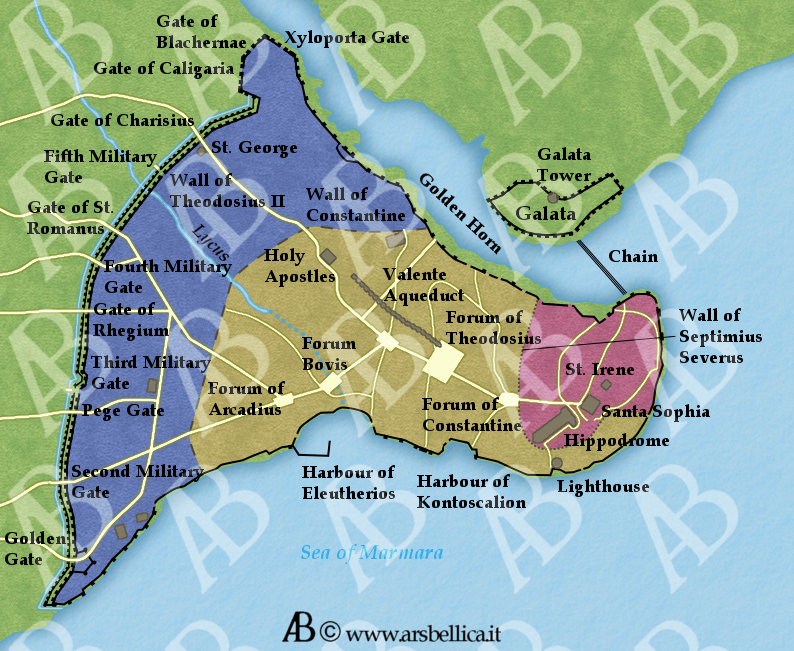
In the early 5th century, Constantinople could count: 11 imperial palaces, 14 churches, 5 markets, 8 public baths and 153 private, 20 public ovens and 120 private, 322 streets, 52 arcades, and 4,388 houses! Already extended by Constantine, the imposing walls were moved farther west in 413 to face the Huns, and then were restructured by Theodosius II after an earthquake in 447.
The walls of the "new Rome" remained untouched for 1,000 years, until the advent of artillery, the ruins are an example of fortification comparable only to the Aurelian walls of Rome.
CONSTANTINOPLE
The siege was prepared with extreme care: Mehmed II negotiated peace with all dangerous states (including Venice), which could "distract" him from his project, then he reinforced the fleet and finally built in record time (5 months!) the fortress of Rumeli Hisar to defend his preparations and, at the same time, close any possibility of supply to Constantinople.
At the giant building, erected in front of a similar post on the other side of the Strait, the turks worked day and night, under the supervision of the Sultan himself. Thousands of workers, soldiers, and even the Vizier. The plant is of the wall traced the name of the Sultan.
The defense of Constantinople was entrusted to a walls (13 miles) very deteriorated and inadequate for that time because designed centuries earlier, in the absence of artillery. The walls could be divided into three main areas: land, sea and the harbour. The first sector consisted of a triple series of dams: a moat 20 feet wide and 5 deep, an early 8-metre-high wall and another wall of 15 meters height plus high towers of 112 covered 20 yards. The port of Golden Horn had both sides protected by city walls and by the District of Galata (the Genoese quarter), while its access to the Bosphorus was barred by a huge chain. Inside the port was the Imperial fleet consisting of 26 ships of which: 10 greek and 16 between Venetian and Genoese.
Overall Constantinople had a large stash of weapons and food; what really lacked was a sufficient number of men to defend its walls.
CONSTANTINOPLE
From Turkish yeni ceri ("new soldier"), the janissaries, as Corps, played an important role in the rise of the Ottoman hegemony in the Muslim world, throughout the 16th century.
Sultan Murad I institutionalized the conscription of young Christians subjugated and their conversion to Islam, subjected to rigorous training, which led to a military order similar to those of the Crusaders. Converts then became fanatical followers and propagators of Islam. Mehmed II could have almost 12,000 in his army, armed with axes, slingshots, crossbows and javelins. Wore a headdress that, according to the military rank, could have up to seven feathers.
Before the end of the 16th century, the janissaries used firearms only occasionally, were divided into regiments ("orte") in turn divided into "ode" (tents) and controlled by "Corbaci" (literally: whom cooks the soup). Usually they lived in barracks around Constantinople and its provinces.
CONSTANTINOPLE
Suspicion of betrayal that weighed on Giustiniani, should invest all other exponents of Western families linked to Constantinople for prestige and wealth. In fact "strange" events occured during the siege of the city: the Papal fleet had remained steadfast to Chios waiting until "changed the wind", the Venetian fleet was blocked to Negroponte in "awaiting orders", since the Senate of the lagoon had just discussed to abandon the city to its fate; also the Turkish ships drag on land passed undisturbed in front of the Genoese Galata district; finally, many Western families remained unscathed by the massacre as a result of the Turkish invasion, enjoying even the concession to choose whether to leave or stay, as well as we new about the concession of trading privileges.
Against the suspect, instead, the valiant behaviour shown by Venetian and Genoese ships during a fight which took place on 20 April. Probably won't ever know the consistency of interests between the Turks and Italian merchants, but the "rumors" reported by chroniclers indicate that, among the participants at the defense of Costantinopole, there was a "responsible ballet" caused by an evident guilty feeling developed in the West after the fall of Constantinople.
CONSTANTINOPLE
Son of an Albanian noble, this commander entered in history for being one of the few, if not the only, able to defeat Turks in their best moment during the Balkan expansion.
Given as a hostage to the Turks and educated to Islam, had fought against Christians gaining great experience, which earned him the nickname of "Iskander Beg", i.e. "Prince Alexander", with reference to Alexander the great. Later, however, the Castriota abjured Islam and back to Catholicism, freed his people.
After his death (1468) Albania was retaken inch by inch from the Turks, but many Albanian communities were force to settle in Southern Italy, where, even today, through the dialects, perpetuate their language. A delightful folksong imagines that Skanderbeg dying called his son and orders to flee beyond the sea: 'once you'll be on the beach you will find a Cypress, perfumed and ill, tie my horse at that Cypress [...] beside my horse, expose my flag to the sea wind, and tie my sword to that flag. When will the north wind will blow, the horse will neighing, the flag shall be flown, and the sword will tinkle from Cypress: the Turkish will hear, and remembering the death that sleeping on my sword, will not follow you where you'll be gone».
CONSTANTINOPLE
The recruitment held by Constantine XI among the citizens of Constantinople had a very modest outcome: in fact the city could count on a population of 70-100,000 inhabitants and at least 20,000 men able to fight, but only 5,000 responded to the appeal launched by the emperor.
The first reinforcements arrived in 1452, were 200 armigers of Papal Legate Isidoro. In January 1453 came two Genoese galleys of Giovanni Giustiniani with 700 men; with him was also the German John Grant, expert in artillery and military engineering. Giustiniani, well-known leader, was appointed commander of all the defenses and intrust its Genoese to defend the delicate Lycus sector. Overall the entire Imperial garrison numbered about 8,000 men including some hundreds of Spanish mercenaries under the command of don Francisco de Toledo.
The Turks are divided into three categories of combatants: the janissaries, well-trained and formidable value, which constituted the regular formations and arrived at a number of about 10,000 men; the basci buzuk, irregular units, large number but with little military value; and finally provincial levers, recruited from all Anatolia. According to the chronicler Nicholas Barbaro, Turkish forces arrived to 150,000 armed men and about 200 ships, but perhaps the most reliable number was 30,000 men and 120 ships.
Perhaps the most interesting element of the Turkish army was definitely the artillery. This had 12 or 13 large-size bombards, many smaller caliber and batteries, whose number varies from a minimum of 24 to a maximum of 50, and numerous pieces of even smaller caliber. Instrumental to this Ottoman advancement in arms production was a somewhat mysterious figure by the name of Orban (Urban), a Hungarian (though some suggest he was German). One cannon designed by Orban was named "Basilica" and was 27 feet (8.2 m) long, and able to hurl a 600 lb (272 kg) stone ball over a mile (1.6 km)! Orban's cannon had several drawbacks however: it took three hours to reload; cannon balls were in very short supply; and the cannon is said to have collapsed under its own recoil after six weeks. Even the transportation process of this artillery piece wasn't easy to carry out: Orban's giant cannon was said to have been accompanied by a crew of 60 oxen and over 400 men.Finally there are chronicle describing that just at the second shot Orban open a gap of about 8 meters in the enemy walls, but luckily for the defenders, in the second day of the siege, it exploded killing both the crew that the same manufacturer.
We have no information on the number of artillery pieces at defenders disposal but we can believe that had to be much more limited than the turkish ones.
CONSTANTINOPLE
The siege was put ashore nearby the walls, with the monumental red-and-gold tent of the Sultan. Muhammad arrived at the camp on April 5, divided his forces in three parts, each under the command of a Pasha: first faced the gates of Fifth Military and Xiloporta; the second dealt with the space between St. Romanus's gate and the sea; the third part, composed of janissaries, which had to exercise the maximum pressure, took position at the point of intersection between the walls and the Lycos river.
On 12 April the largest Turkish bombard is placed in front of the St Romanus gate and open fire along with all other artillery pieces. After six days of intense bombing, damage products are still small due to the imprecision of the Muslims crew and the skill of the defenders that quickly repairing breaches with debris, stones and earth. The April 18 Muhammad II, quickened by the bad results, ordered a general assault. The Turks launched with great vehemence against the enemy, which, for its part, responded with a hellish mass of blows, departed from harquebuses, bows, crossbows, small bombarde and Greek fire (boiling pitch, which was burned before thrown on the enemy), managing to drive out the Turks over the moat.
In addiction, against the Turks, two days later, three Genoese ships brought to the Byzantines weapons and supplies, just by hiding in the Golden Horn, and escaping from the Turkish fleet that unsuccessfully tried to capture them. Then the Sultan gives order to level the ground for about three kilometers (using thousands of slaves, of course) and throw on a species of wood lane coated with grease, on which, by force of arms and with the help of oxen, moves 70 ships in a river which flows into the waters of the Golden Horn. This Turkish Squadron manages to enter into the Harbour and to repel the Christians attempt to burn the muslim's battleships. Not enough fot the Sultan, that order to built a 700-metre bridge to transport the dismounted troops from one side to the other.
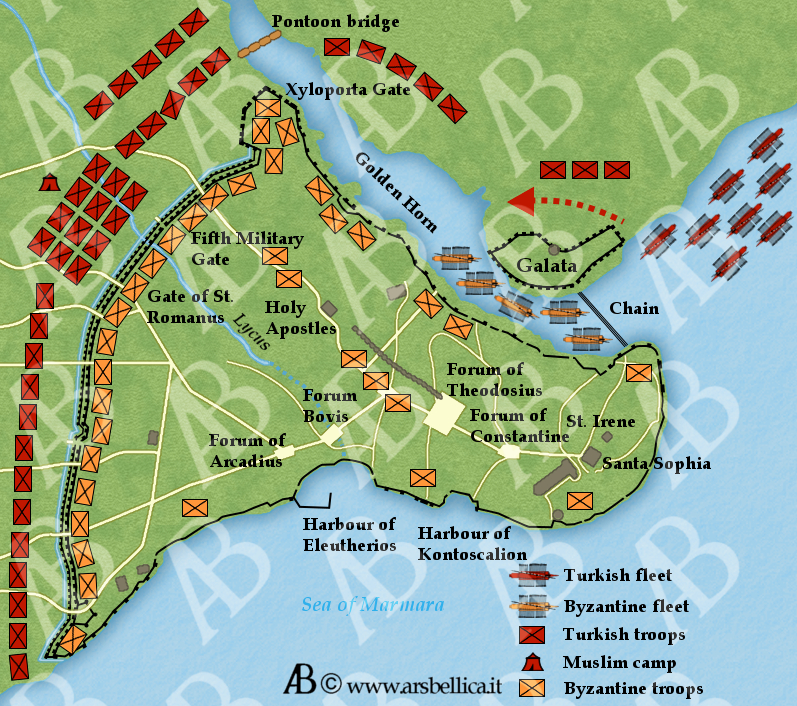
The May 7 and 12 are unleashed two new assaults by 30,000 and 50,000 men, but are once again repelled. Was constructed an enormous siege wooden Tower and on the 18 the Turks began their attack supported by this impressive war machine. The Giustiniani managed to destroy it with barrels of gunpowder let roll at the foot of the tower and then explode. Failed this series of attacks, the Turks began to dig tunnels under the walls of the cities, but the German John Grant to thwart this move ordered to dig parallel tunnels to those of the enemy as to destroy them. It happened that the two factions have come into contact under ground and engaging clashes with digging tools, daggers, axes and whatever. we can then say that for how much effort the Turks did, the Byzantines were always there to contrast the entire army.
It is said that Mehmed II was about to abandon the siege of the city, due to the results of previous attacks and also due to the fact that the supplies of his army were running out. But one of his advisers, Zagan Pasha, was able to convince him to try at least one last attempt, ordering a simultaneous attack by land and sea for May 29.
The fleet had to open fire from the port to keep the Christian forces busy in limiting the damages on that side, and therefore preventing them to strengthen other parts on which it would concentrate the Turkish attack. The main objectives were three: the walls at the Adrianople gate, the so-called third military port and finally the gate of St. Romanus, where would be focused the maximum pressure. For the assault were built stairs, bundles to fill the moats and hooks to remove the Palisades that covered the breccias. When the defenders saw all the fervor in Turkish preparations and the fires that were lit in their field, realized that the crucial moment was arrived; the Emperor gathered all his captains for a final mass in Hagia Sophia. Constantinople was defended by about 4,000 armed between Greeks, Venetians, Genoese and Spanish. At the stroke of midnight the Turkish camp fires were extinguished, a great silence ruled the scene, then the drum roll and fanfare of trumpets of the attackers split up every doubt.
The most important assault, on the gate of St. Romanus was organized in three waves: the first was that of the basci buzuk-; the second was of Anatolian; the third assault was for the janissaries. The aim was to let slaughter the firsts two divisions to run out of ammunition defenders and then call elite troops. So it was: the first two waves were massacred by enemy fire, but allowed the janissaries to arrive on the walls, and confront the men of the Giustiniani. This first impact failed but at the subsequent, the Genoese leader was wounded and carried immediately away from the center of the battle; the janissaries feigning retreat and driven back once again, but this time were supported by their other companions (infiltrated into the city through an unattended circus door), who had appeared behind the Byzantines now panicked.
Due to these signs of yelding, Constantine immediately came along with don Francisco de Toledo and a small group of nobles and warriors, but was soon shot to death and the last resistances of the city crashed suddenly.
Some tried to escape into the sea, others went to protect their families, but the looting that demolished the city lasted until 31 May when it was ordered to return to camp.
Is not easy to define precisely the losses suffered by the two sides, due to the discrepancy of data provided by sources who have come to us. The figures most likely are about 4,000 citizens killed and 25,000 deported to slavery. What is certain is that, after looting, the city was almost completely uninhabited, considering the fact that Muhammad let immigrate in it many thousands of Turks.
For sure very few Greeks managed to escape. The 10 Byzantine ships anchored at the port had been overloaded, making them easy prey for the Turkish fleet; while the 16 vessels "Westerners", almost completely empty, could easily flee into the Genoese and Venetian Islands in the Aegean.
There are no reliable data on Ottoman casualties, although we can imagine how much expensive, in terms of lives, was the price for the conquest of the city.
CONSTANTINOPLE
Tamerlane (Timur-e lang "Timur the lame") was the greatest conqueror after Genghis Khan, and right from the exploits of great Mongolian wanted to restart the descended from a dynasty of Turkestan.
He managed, at least in part: subdued Central Asia and southern Russia, in 1398 he arrived in India, crossed into Persia, Mesopotamia and Syria and arrived in Anatolia just in time to destroy the Ottoman army of Bayazid (who was to give the coup de Grâce to Constantinople); finally returned to Central Asia.
The really important fact of these Timur enterprises is that with the capture of Bayazid, he opened, among the Turks, two decades of internal struggles of which the Byzantines were not able to take advantage, they get mixed up in this internal struggles attracting towards them even more hatred from Turkish part and then in 1422 the Turks returned in front of the walls of Constantinople.
According to legend, when the Turks raided in Santa Sofia, a wall opened in front of the priest who was serving a mass, he entered in this passage with the Holy Chalice while the wall closed behind him. It will reappeared to finish the mass when Constantinople will Christian again.
Instead, when Mehmed II entered in Hagia Sophia was charmed by it(and this is not a legend!). The historian Regar Tursunzoda Bey described: "the dome competes with the nine spheres of Heaven [...], the walls are covered in place of plaster, fragments of glass and gold, so nobody can see the joints; the floor is covered with colored marbles so that those who look from Earth to heaven has the impression of seeing the firmament, and those who watch from heaven to Earth has the impression of seeing the ocean waves [...] In the dome a skilled artist has depicted a man that anywhere you looked at him seemed to watch the observer».
The latter was the great mosaic of Christ Pantocràtor ", symbolizing the power of Byzantium, but in observance of Islamic law on the images, was heavily plastered along with other mosaics, and the Church of Hagia Sophia was converted into a mosque.
CONSTANTINOPLE
The fall of Constantinople did not have however so relevant consequences on European policy, except in Italy where it was signed the peace (Treaty of Lodi, 1454) among the Italian states ready to be United as to face the possible invasion of the Turks.
As for all the other great States of Europe the wars and conflicts between them were destined to deteriorate, so that the future Pope Pius II (known as Enea Silvio Piccolomini) wrote: "every town has its own King. There are many principles as many houses. How can I persuade Christian leaders to take up arms toghether?».
But despite the looting, the destruction of the capital and the large Ottoman organization, the spirit of the Eastern Empire remained alive, influencing all the Balkan countries, while the Greek Orthodox Christianity retained its Holiness preserving part of the Slavic peoples from the expansion of Islam, and to the East, far away, the birth of a great power: Ivan III of Russia, husband of the daughter of Thomas Palaiologosin (the grandson of the last emperor of Byzantium) led the Byzantine double-headed eagle on Moscow, the "third Rome", assigning to Russia a role once owned by Costantinople.
CONSTANTINOPLE
The word "Turks" still evokes in most of us a very cruel and ruthless people, something that has some type of feedback. But the Christians imposed violently too their "law" in the past centuries; especially to populations often known as Pagan: the cruelty and ostentation of tortures was then the only way to give a warning to protect public order.
Regarding the Turks they were of Islamic religion, which means Islamic law drew inspiration from the Quran itself, then: the community does not have thier judges and thier laws, the police could apply corporal punishment without denouncing the reo or alleged that on the Court, the judiciary was much for wasted no time, could held a process, issue a judgment and send the accused to death in just 24 hours!
As an example of the cruelty of the time of the Turkish people we can take for example decapitation: this happened on the street closest to the executioner, on the body were a sign with the judgment written on, and the head, once cutted, was layed in the arms, if the deceased was a Muslim, between the legs if "infidel".
Bibliography:
Livio Agostini, Piero Pastoretto, Le grandi Battaglie della Storia, Viviani Editore, Il Giornale, 1999